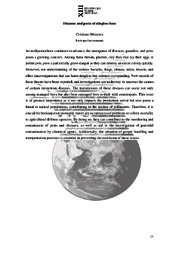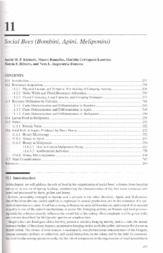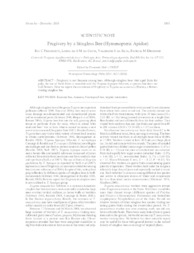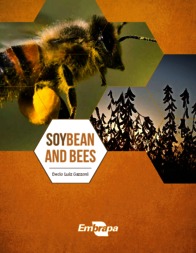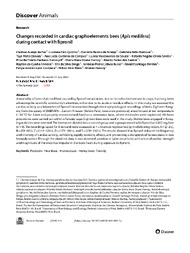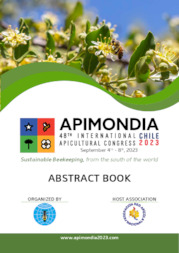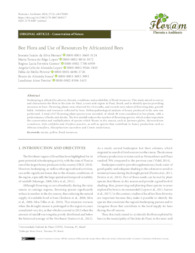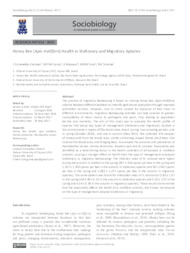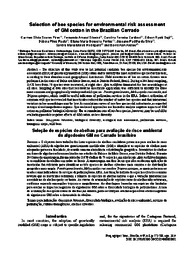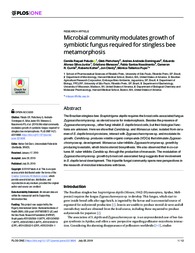Search Publications
Filter by:
| |
| Author(s): KLEINERT, A. M. P.; RAMALHO, M.; CORTOPASSI-LAURINO, M.; RIBEIRO, M. de F.; IMPERATRIZ-FONSECA, V. L. In this chapter, we will address the role of food in the organization of social bees colonies from foraging activity to its use on offspring feeding, emphasizing the characteristics of the two main re... ... |
| Author(s): PERUQUETTI, R. C.; COSTA, L. da S. M. da; SILVA, V. S. da; DRUMOND, P. M. Frugivory is not frequent among bees. Although stingless bees visit aged fruits for pulp, the use of fresh fruits is recorded only for Trigona hypogea Silvestri, a species that does not visit flowers.... ... |
| |
| Author(s): PAZ, C. A. da; EIRÓ-QUIRINO, L.; ARAÚJO, D. B. de; BARBOSA, G. B.; CÂMARA, T. M.; CAMPOS, A. L. C. de; SOUZA, L. V. de; SANTOS, R. N. O.; HARTCOPFF, P. F. P.; HAMOY, M. K. O.; SANTOS, M. F. dos; FERREIRA, R. da C.; DEIGA, Y. da S.; RUSSO, A. P. L.; PEREIRA, D. S.; CONTRERA, F. A. L.; MUTO, N. A.; HAMOY, M. A mortality of bees (Apis mellifera) caused by fipronil intoxication, due to its indiscriminate use in crops, has long been attracting the scientific community’s attention, either due to its acute or... ... |
| Author(s): MAUÉS, M. M.; CAMPBELL, A. J.; SILVA E SILVA, F. D. da; LEÃO, K. L.; CARVALHEIRO, L. G.; MOREIRA, E. F.; MERTENS, F.; KONRAD, M. L.; MENEZES, C. Agricultural expansion is a major driver of habitat loss, which triggers biodiversitydecline, including wild pollinators, and affects crop production. 76% of world crops are dependenton biotic pollina... ... |
| Author(s): MORAES, J. I. da S.; LOPES, M. T. do R.; FERREIRA-GOMES, R. L.; LOPES, A. C. de A.; PEREIRA, F. de M.; SOUZA, B. de A.; PEREIRA, L. A. Beekeeping is affected by adverse climatic conditions and availability of floral resources. This study aimed to survey and characterize the flora in São João do Piauí, a semi-arid region in Piauí, Bra... ... |
| Author(s): CESTARO, L. G.; ALVES, M. L. T. M. F; MESSAGE, D.; SILVA, M. V. G. B.; TEIXEIRA, E. W. The practice of migratory beekeeping is based on moving honey bee (Apis mellifera) colonies between different locations to intensify agricultural production through improved pollination services. Howe... ... |
| Author(s): PIRES, C. S. S.; SILVEIRA, F. A.; CARDOSO, C. F.; SUJII, E. R.; PAULA, D. P.; FONTES, E. M. G.; SILVA, J. P. da; RODRIGUES, S. M. M.; ANDOW, D. A. The objective of this work was to list potential candidate bee species for environmental risk assessment (ERA) of genetically modified (GM) cotton and to identify the most suited bee species for this... ... |
| Author(s): PALUDO, C. R.; PISHCHANY, G.; DOMINGUEZ, A.-A.; SILVA JÚNIOR, E. A.; MENEZES, C.; NASCIMENTO, F. S.; CURRIE, C. R.; KOLTER, R.; CLARDY, J.; PUPO, M. T. Abstract: The Brazilian stingless bee Scaptotrigona depilis requires the brood cells-associated fungus Zygosaccharomyces sp. as steroid source for metamorphosis. Besides the presence of Zygosaccharomy... ... |
Observation
Some of Embrapa's publications are published as ePub files. To read them, use or download one of the following free software options to your computer or mobile device. Android: Google Play Books; IOS: iBooks; Windows and Linux: Calibre.
Access other publications
Access the Agricultural Research Database (BDPA) to consult Embrapa's full library collection and records.
Visit Embrapa Bookstore to purchase books and other publications sold by Embrapa.

